
a web page by Don Roberson |
 |
||||||
LARKS Alaudidae |
||||||
|
||||||
JULIET Wilt thou be gone? It is not yet near day. It was the nightingale, The Shakespearean lark was Eurasian Skylark Alauda arvensis, known across the Holarctic for its songs, given on fluttering wings and cascading down from high in the sky, from dawn to dusk. "Skylarking" — singing while hovering above its grassland habitat — is known from various larks. The photo (above) shows a skylarking Somali Short-toed Lark above short-grass plains in east Africa, set against an overcast sky. Larks also sing from perches in small trees or bushes, or from the ground, as demonstrated by this Rufous-naped Lark (left) from the floor of Ngorongoro Crater, Tanzania. Rufous-naped Lark occurs widely in south & east Africa, where it is often the "standard" lark to learn. Even the strange Greater Hoopoe-Lark (below) — a bird of sandy deserts in north Africa and the Middle East — has an ascending and descending series of lovely whistles, which it gives from a vertical flight. While it appears to almost 'disappear' while running across barren sand, it shows a dramatic black-and-white wing pattern in flight.
|
||||||
 |
||||||
Some really cool larks are in southern Africa. I'm quite fond of Spike-heeled Lark (left) of southwestern Africa, not only for its fine English name, but for its actual, very long and impressive back-forward pointing spike, which you can see in this shot. Two scarce and local species that I photo'd from a distance are the scarce and localized Pink-billed Lark (below left) that we found in same upland Transvaal grasslands as the endangered Botha's Lark Spizocorys fringillaris in eastern South Africa, and Red Lark, which inhabits spikey-brushed sand dunes in a tiny range in western South Africa (below right).
|
||||||
|
||||||
Many Mirafra larks sing while hovering high over the grasslands; the widespread Mirafra from north Africa to India is called the Singing Bushlark M. cantilans (split from the Australasian Bushlark M. javanica which ranges from southeast Asia to Australia). The Red-winged Lark mimics numerous other species, incorporating calls of 20 other species in a 15-minute song in Tsavo West park, Kenya (Keith et al. 1992). John McAllister advises that the South African endemic (except for a small isolated population in central Zimbabwe) Latakoo Lark M. cheniana deserves mention. It's been called "Singing Bush Lark," "Southern Singing Bush Lark" and "Melodious Lark." It has been recorded imitating at least 57 species "including francolins, guinea fowl, plovers, coursers, louries, cuckoos, bee-eaters, swifts, larks, swallows, chats, warblers, pipits, longclaws, shrikes, starlings, sunbirds, ploceids, waxbills and canaries" (Maclean 1984). McAllister states that in the breeding season it sings in flight or continuously from a perch and is "quite wonderful to hear." |
||||||
|
||||||
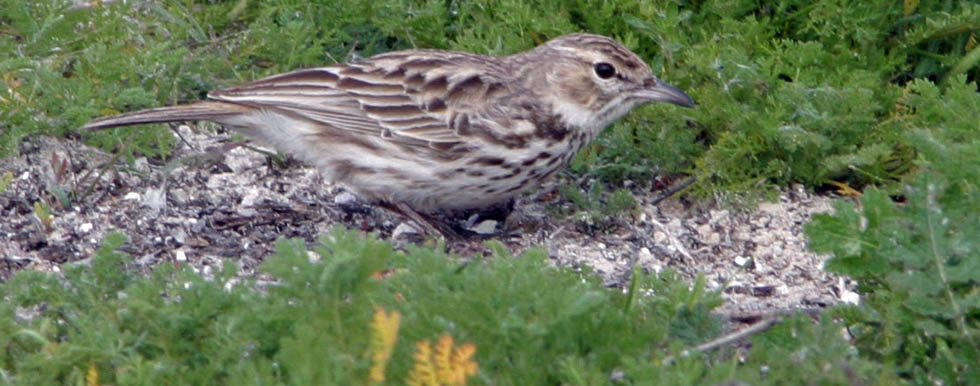 |
||||||
| I was astonished by the variety in size, color, and bill shape in larks of western South Africa. The three shown above are: Karoo Long-billed Lark (to left), Large-billed Lark (top right), and Karoo Lark (full-width photo just above). The Karoo Long-billed Lark recalls Cactus Wren of sw U.S. and Mexico to me; it is one of five species that were created when the initial "Long-billed Lark" was split (Ryan & Bloomer 1999). Large-billed Lark has a heavy wedge-shaped bill, while Karoo Lark has a thin bill. The latter lives in monogamous pairs in habitat, with the male singing on territory throughout the year (de Juana 2002). | ||||||
|
||||||
|
||||||
Although the lion's share of larks are in Africa, the deserts and barren plateaus of Eurasia abound in larks. During a search of Manchurian grasslands in China, our group accidentally discovered a nest with 4 eggs of Asian Short-told Lark (right), a small lark of highland grasslands in eastern Asia. We quickly backed away and in due course the brooding female was back in her place. Three more examples below of desert or plateau larks are shown below: Crested Lark (below left) and Greater Short-toed Lark (below center) — both birds of Arabia and the Middle East — and Mongolian Lark (below right) of far eastern uplands. Crested Lark has a very wide distribution from Spain and North Africa into China. Mongolian Lark's range is centered in Mongolia, and spills into north China and south Russia, in dry grasslands. It is a short-distance migrant in winter. |
||||||
|
||||||
| Because they hide in grassland and open country, most larks tend to be muted in coloring, varying among grays and brown to buffy-pink. The exception are the sparrow-larks (genus Eremopterix), small larks of African thornscrub and savanna, in which the males can be patterned in blacks, whites, and chestnuts, at least around the head and neck. There are 7 species of sparrow-larks in genus Eremopterix, as well as Madagascar Lark Eremopterix hova. Unlike its congeners in mainland Africa and in south Asia, Madagascar Lark is dull brown and streaky, like many other small larks. All members of the sparrow-lark genus spend a lot of time walking on the ground, and they are often found in pairs. Males wear the bright colors; females are decided less colorful. Two examples are Ashy-crowned Sparrow-Lark (male, below left), which inhabits dry scrub and rocky country in India, and Fischer's Sparrow-Lark (below right), a somewhat nomadic species that prefers bare fields in arid grassland of Kenya and Tanzania. The distribution of sparrow-larks in east Africa has been changing over the decades. Apparently, Chestnut-headed Sparrow-Lark E. signatus, another east African endemic, has displaced Fischer's Sparrow-Lark in eastern Kenya (Keith et al. 1992); Fischer's is still quite common in Tanzania. | ||||||
|
||||||
| There are many interesting identification problems among the larks, and between larks and other cryptic birds. In addition, long-distance vagrancy can occur. When California's first vagrant Skylark Alauda arvensis appeared on Pt. Reyes in 1979, it was misidentified initially as "Smith's Longspur." Dr. L.C. Binford of the California Academy of Science was the first to determine it was actually a even better rarity: an Old World lark. Further research would show it to be one of the northeastern Asian races, so it was from Siberia. This individual returned to Pt. Reyes for the next six consecutive winters. Details of this fascinating detective story and the eventual unambiguous solution appear in Morlan & Erickson (1983). | ||||||
Fortunately, other larks are not so restricted, and some of them I found to be be very lovely indeed, including Spike-heeled Lark (right; a different race than shown farther up this page), as it sits among the thorns of thornscrub in western South Africa. Red-capped Lark is even more widespread — from the Serengeti grasslands of east Africa to the arid hardpack of Etosha NP in Namibia, where this photo was taken (below). So take a hike and have a lark! |
||||||
|
||||||
Photos: The Somali Short-toed Lark Calandrella somalicus athensis was skylarking at Engikaret, Tanzania, on 7 June 2018. The Rufous-naped Lark Mirafra africana was singing in the Ngorongoro Crater, Tanzania, on 11 June 2018. The Greater Hoopoe-Lark Alaemon alaudipes was running in sandy dunes of the United Arab Republic in March 2001. The Spike-heeled Lark Chersomanes albofasciata was at Etosha NP, Namibia, in July 2005. The Pink-billed Lark Spizocorys conirostris was near Wakkerstroom, Transvaal, South Africa, on 26 July 1996. The Red Lark Calendulauda burrawas near Brandvlei, South African, on 9 July 2005. The story of Beesley's Lark Chersomanes beesleyi includes the lark, the Engikaret plains in Arusha Province, Tanzania, and the Reserve sign, all from 7 June 2018. The Red-winged Lark Mirafra hypermetra was in Tsavo West NP, Kenya, on 26 Nov 1981. Both the Karoo Long-billed Lark Certhilauda subcoronata and the Large-billed Lark Galerida magnirostris were in the karoo near Brandvlei, South Africa, on 8 July 2005. The Karoo Lark Calendulauda albescens was at West Coast NP, South Africa, on 5 July 2005. The Foxy Lark Calendulauda alopex was at Tarangire NP, Tanzania, on 10 June 2018. The Pink-breasted Lark Calendulauda poecilosterna was in thornscrub south of Mwanga, Tanzania, on 1 June 2018. The cinnamon-backed Horned Lark Eremophila alpestris actia was at Moss Landing, California, on 13 July 2016; the pale race E.a. nigrifrons was on the Qinghai Plateau, China, on 17 June 2004. The nest with eggs of Asian Short-toed Lark Alaudala cheleensis was in the Manchurian grasslands of Baichang, northeast China, on 7 June 2004. The Crested Lark Galerida cristata was at Maegan, Israel, on 28 Nov 1981. The Greater Short-toed Lark Calandrella brachydactyla was Sharm-el-sheik, Sinai, on 7 Nov 1981. The Mongolian Lark Melanocorypha mongolica was at Baichaing, China, on 12 June 2004. The male Ashy-crowned Sparrow-Lark Eremopterix griseus was at Ranthambore, India, in March 2001. The male Fischer's Sparrow-Lark Eremopterix leucopareia was at Tarangire NP, Tanzania, on 8 June 2018. My second photo of Spike-heeled Lark Chersomanes albofasciata is from the karoo near Brandvlei, South Africa, on 7 July 2005. The Red-capped Lark Calandrella cinerea was in Etosha NP, Namibia, on 18 July 2005. All photos © Don Roberson; all rights reserved. Special thanks to John McAllister of Wakkerstroom, South Africa, for comments to an earlier version of this page. Bibliographic note: There is no "family book" per se, but a fine introduction to this family, with some very good photos, is in de Juana (2004). Literature cited:
|
||||||
 The Larks are a large family of ground-dwelling birds, most of them in open country habitats from desert to grassland to stony steppe, and they are generally small and cryptic in color. If the public takes any notice of them, it is because of their songs, perhaps most famously in Shakespeare's Romeo & Juliet, Act 3, Scene 5:
The Larks are a large family of ground-dwelling birds, most of them in open country habitats from desert to grassland to stony steppe, and they are generally small and cryptic in color. If the public takes any notice of them, it is because of their songs, perhaps most famously in Shakespeare's Romeo & Juliet, Act 3, Scene 5: Larks are primarily Old World birds, and their center of distribution is in Africa, accounting for 80% of the world's species (78 species), of which 60 are endemic to Africa.
Larks are primarily Old World birds, and their center of distribution is in Africa, accounting for 80% of the world's species (78 species), of which 60 are endemic to Africa. 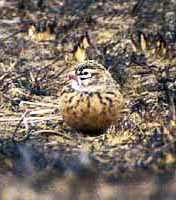
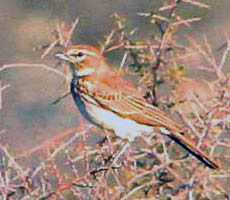
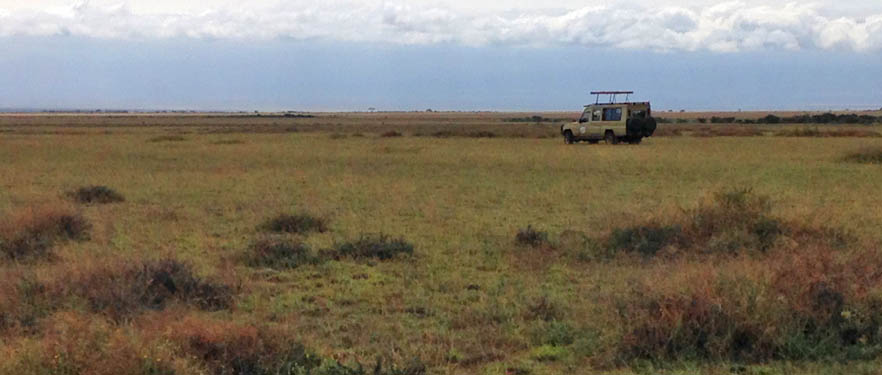
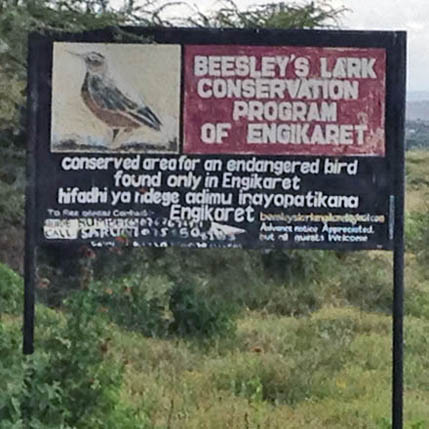
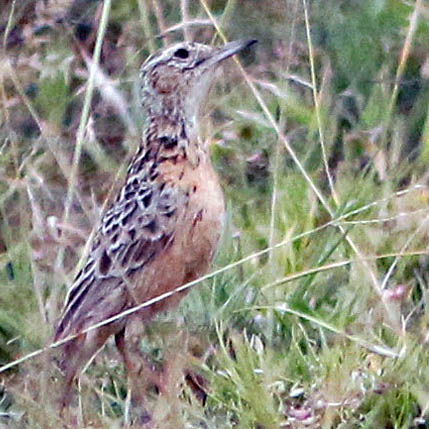
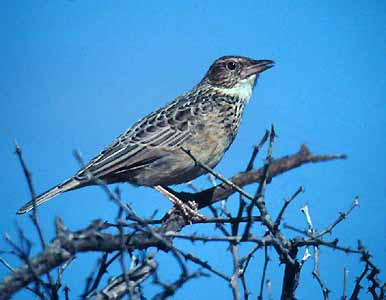 Over a third of the world's larks are in the genus Mirafra: these are often chunky, red-winged, buffy grassland birds of which Red-winged Lark (left) of east Africa is an example. I confess that when I took this photo in Kenya in 1981, and then used the field guide available (Williams & Arlott 1980), I misidentified this bird as a "Flappet Lark M. rufocinnamomea." I've tried to re-identified it as several things over the years, but only with the publication of Zimmerman et al. (1996) did I get this one right. Note particularly the scaly back pattern and the neat anchor-shaped interior markings on the outer scaps and tertials (recalling similar patterns on juvenile Red Knot). My problems with this bird illustrates just how poorly the identification of some larks has been treated in past literature.
Over a third of the world's larks are in the genus Mirafra: these are often chunky, red-winged, buffy grassland birds of which Red-winged Lark (left) of east Africa is an example. I confess that when I took this photo in Kenya in 1981, and then used the field guide available (Williams & Arlott 1980), I misidentified this bird as a "Flappet Lark M. rufocinnamomea." I've tried to re-identified it as several things over the years, but only with the publication of Zimmerman et al. (1996) did I get this one right. Note particularly the scaly back pattern and the neat anchor-shaped interior markings on the outer scaps and tertials (recalling similar patterns on juvenile Red Knot). My problems with this bird illustrates just how poorly the identification of some larks has been treated in past literature.


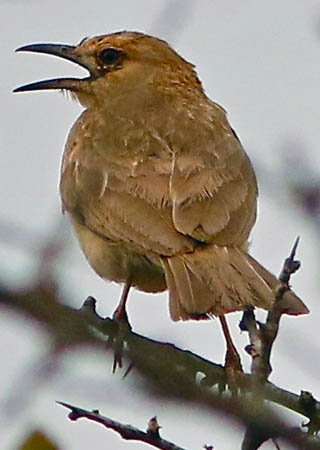
 Only one species of lark is found widely outside the Old World, and it nests on all larger continents (missing in Australia and Antarctica). It is Horned Lark (left & below), a bird which is at home in open spaces from the tundra shores of Canada to the open grasslands of the Great Plains to the high meadows of the Andes, and then across the Holarctic. In Europe the species is called "Shore Lark," but the English name "Horned Lark" is a good one for all races, and you can see the short feathered "horn" on the side of the crown in this shot. There are numerous subspecies: this adult (left) is of the colorful cinnamon-backed race E. a. actia that breeds in western North America. Contrast its coloration with the pale and frosty subspecies nigrifrons that breeds on the Tibetan Plateau of China (below):
Only one species of lark is found widely outside the Old World, and it nests on all larger continents (missing in Australia and Antarctica). It is Horned Lark (left & below), a bird which is at home in open spaces from the tundra shores of Canada to the open grasslands of the Great Plains to the high meadows of the Andes, and then across the Holarctic. In Europe the species is called "Shore Lark," but the English name "Horned Lark" is a good one for all races, and you can see the short feathered "horn" on the side of the crown in this shot. There are numerous subspecies: this adult (left) is of the colorful cinnamon-backed race E. a. actia that breeds in western North America. Contrast its coloration with the pale and frosty subspecies nigrifrons that breeds on the Tibetan Plateau of China (below):

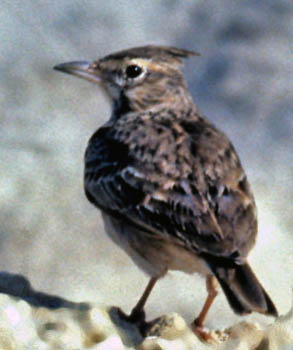
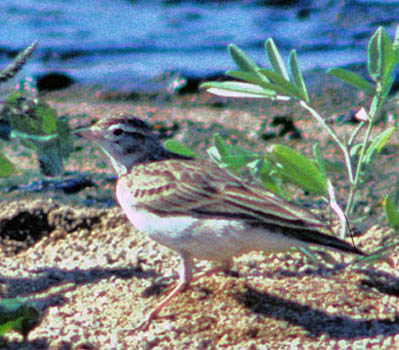
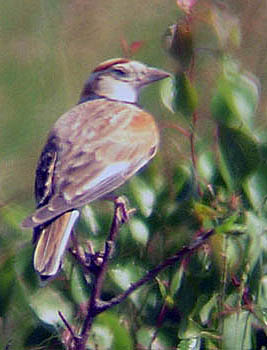

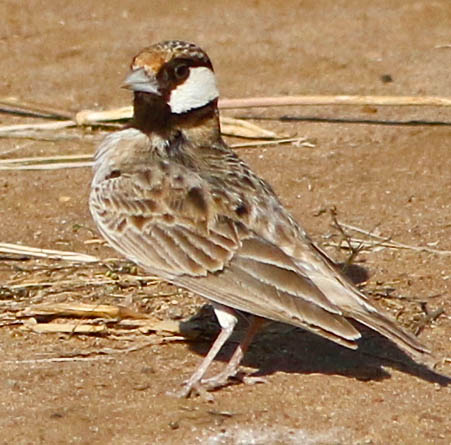
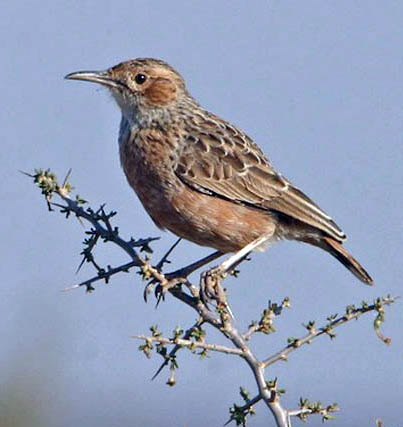 A goodly number of larks are very local and some are rare to endangered. These include Ash's Lark Mirafra ashi, restricted entirely to a small area in coastal Somalia (there are no recent surveys, and Somalia is not safe to visit), the Liben Lark Heteromirafra archeri of Ethiopia (that now includes sidamoensis of northwest Somalia), and Obbia Lark Spizocorys obbiensis of coastal dunes in Somalia. For Rudd's Lark Mirafra ruddi, a Transvaal endemic, 85% or more of the world population occurs within 100 km of the towns of Wakkerstroom and Memel in South Africa, in the higher altitude grasslands between 1600-1800 m (Harrison et al. 1997). Clearly, anyone trying to see all the larks of the world is going to have a very difficult time.
A goodly number of larks are very local and some are rare to endangered. These include Ash's Lark Mirafra ashi, restricted entirely to a small area in coastal Somalia (there are no recent surveys, and Somalia is not safe to visit), the Liben Lark Heteromirafra archeri of Ethiopia (that now includes sidamoensis of northwest Somalia), and Obbia Lark Spizocorys obbiensis of coastal dunes in Somalia. For Rudd's Lark Mirafra ruddi, a Transvaal endemic, 85% or more of the world population occurs within 100 km of the towns of Wakkerstroom and Memel in South Africa, in the higher altitude grasslands between 1600-1800 m (Harrison et al. 1997). Clearly, anyone trying to see all the larks of the world is going to have a very difficult time. 